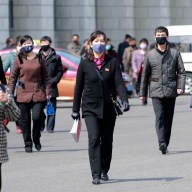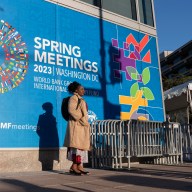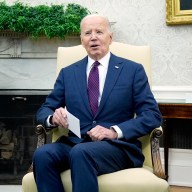TORONTO – The violent images of the 1979 Iranian revolution – women clad in chadors chanting passionately, protesters burning American flags and students being beaten on the street – are hauntingly similar to those that continue to trickle out of the country today.
But the tables have turned and the generation with a revolutionary spirit captured by a Canadian photojournalist 30 years ago has now become an oppressive regime that cracks down on a new generation that want democracy and freedom.
Wednesday’s unveiling of Canadian Press photographer Peter Bregg’s exhibit “Hostage: The 1979 Crisis in Iran” marked the 30th anniversary of the day students stormed the U.S. Embassy in Tehran and seized 66 Americans holding them hostage for 444 days.
Six other Americans hid for three months in the Canadian and Swedish embassies until they were spirited out of the country with Canadian passports in January 1980, an escape that would be dubbed the Canadian Caper.
For Canada’s former ambassador to Iran Ken Taylor, who was among a group of notable Canadians at the exhibit, the images stirred up memories of a tumultuous and dangerous revolution that left deep scars on the country.
The images shot by Bregg are some of the few available in the West from a historical moment in an Islamic country still locked in a struggle for democracy, freedom and human rights.
Taylor found similarity in the images with the unrest this summer following the Iranian government’s bloody crackdown on opposition protesters claiming President Mahmoud Ahmadinejad’s re-election was fraudulent.
“Again the television is full of street demonstrations, which was certainly the case 30 years ago,” he said.
Taylor’s role in the Canadian Caper earned him an Order of Canada and a Congressional Gold Medal from U.S. President Ronald Reagan, who lauded his “valour, ingenuity and steady nerves.”
Along with the CIA and other diplomats, Taylor helped the Americans obtain fake Canadian identities, complete with passports, driver’s licences and Canuck disguises.
But Taylor, who stays in touch with the Americans he aided, is humble about his actions.
“I think you try to give the impression that everything’s under control,” he said. “And I always had the thought that we were going to be able to pull this off.”
Bregg, along with Canadian Press reporter Doug Long, survived a car wreck in the desert and 24 hours of fear after being taken blindfolded at gunpoint by revolutionary guards.
“My time in Iran was intense, probably the most intense six months of my life,” he said.
Bregg’s daughter Trae, 40, said that as an 11-year-old girl, her parents shielded her from knowing the truth about the precarious situation that kept her father away.
She does, however, remember the trip to Disney World the family took when he returned.
“At the time, we didn’t know anything about Iran – what we did know was that there were a bunch of bad guys with long beards and guns and they didn’t like anyone from America or Canada,” she said. “Dad was there and it was very, very dangerous, but not to worry.”
“It didn’t hit me until I was older and now it actually makes me feel sick sometimes when I think about my dad, as a 30-year-old guy, being held up at gunpoint, I mean that is crazy.”
After American and British reporters were kicked out of Iran, and long before Twitter and YouTube, Bregg and Long were the main source in the West for information about the Iranian revolution.
Long said things started out smoothly, with a briefing from Taylor, but quickly turned once the Iranians found out what the Canadian ambassador had done.
“What Peter and I didn’t know was that the ambassador had been shielding six Americans in his basement.” Long said. “Just days after we met, they were able to flee the country successfully, passports had been provided for them, so at that point it wasn’t such a great thing to be a Canadian reporter.”
“Of course there was no way he could let us know what was transpiring at his embassy,” Long said. “He successfully completed his mission, and we carried on the best we could.”












